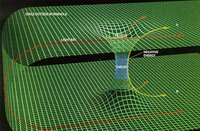 DARPA, the US military’s advanced concepts research team, is working on an ambitious project to create nothing less than an ‘Einstein-Rosen bridge'. Referred to by some physicists as ‘timeholes,’ it is thought that the US military is set to introduce time travel to the battlefield by the end of the decade.
DARPA, the US military’s advanced concepts research team, is working on an ambitious project to create nothing less than an ‘Einstein-Rosen bridge'. Referred to by some physicists as ‘timeholes,’ it is thought that the US military is set to introduce time travel to the battlefield by the end of the decade.“This is clearly the future of armed conflict,” says DARPA lead scientist Tetsuo Hasegawa, “the ability to go back in time and destroy the enemy before tensions have even arisen would represent an unprecedented advantage in the history of warfare.”
Hasegawa has been working on the ERB project since 1998, but with little progress to show for. Recently, however, he came across the idea of creating a Lorentzian traversable wormhole – a special kind of wormhole that would allow a human to travel from one side of the wormhole to the other.
Indeed, only recently has the idea of creating a working Einstein-Rosen bridge become feasible. Long the stuff of science fiction and heady theoretical physics, the ability to create a tunnel that interlinks the fabric of spacetime is now within our grasp.
“The answer was starring us right in the face,” says Hasegawa. “If a Lorentzian spacetime contains a compact region Ω, and if the topology of Ω is of the form Ω ~ R x Σ, where Σ is a three-manifold of nontrivial topology, whose boundary has topology of the form dΣ ~ S², and if furthermore the hypersurfaces Σ are all spacelike, then the region Ω contains a quasipermanent intra-universe wormhole.”
It was at that point in their research that the DARPA team knew they were on to something. As Hasegawa noted, “There were high-fives around the lab that day, let me tell you.”
In physics, a wormhole is a hypothetical topological feature of spacetime that is essentially a "shortcut" through space and time. A wormhole has at least two mouths which are connected to a single throat. By making the wormhole traversable, the US military hopes to send manned vehicles from one mouth to the other by passing through the throat.
In addition to going back in time before the enemy is ready, it is also hoped that “quick-trip” time jumps will be made to the recent past in the event of a mistake or miscalculation on the battlefield. In this sense, the ERB would essentially act as a real-world 'undo' button. It is even speculated that so-called “foresight trips” will be made to the future to assess potential outcomes.
When asked about such ethical and practical problems as disrupting sensitive timelines or the grandfather paradox, Hasegawa noted, “Sure, those are potential issues, but I think you’re missing the point – this is time travel we’re talking about.”
DARPA hopes to roll-out a prototype ERB for testing in late 2008.
Tags: Einstein-Rosen bridge, time travel.

1 comment:
Well, truth can be stranger than fiction. This was obviously an April Fool's joke (duh -- although I got the sense that some people on Betterhumans thought I was being serious (scary). But check this out for real:
http://www.physorg.com/news63371210.html
'Time Machine' In Ten Years?
Armchair Anarchist Apr 04, 2006 - Show original item
As a child, Ronald Mallett wanted to travel back in time to try to prevent his father's death, and hence went on to study physics. Despite now believing that the present cannot be affected by meddling with the past, he has announced his intention to build a 'time machine' based around circulating laser beams, using equations based on Einstein's work on realtivity. The project is in need of financial backers, but he reckons he can have the desktop device made and ready to confirm (or falsify) his theory within a decade. Stop giggling at the back.
Post a Comment